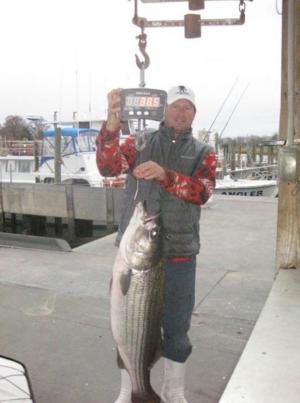On Sunday Dec. 4, a 62-pound striped bass was brought in to Hook 'em and Cook 'em at Indian River Inlet. According to the angler, Paul Barbara, the fish was caught on a 32-ounce MOJO at Overfalls Shoal. Captain Kenny Kaiss netted the fish and brought it aboard the Island Girl. Unfortunately, the boat was stopped by DNREC Enforcement officers and given a warning because they were fishing in the EEZ more than three miles from the demarcation line. This incident has led to an investigation as to where the fish was caught. If it was taken in the EEZ, it would be an illegal fish and disqualified. I spoke with DNREC Enforcement and they told me a final decision would not be made until late in the week.
Fishing report
The good news is rockfish have finally moved into the Rips between Cape Henlopen and Cape May and in the ocean off Rehoboth Beach. Everything I have seen so far indicates the rock are pretty big as is normal for the first of the run. Trolling with big plugs, MOJOs and double bucktails have been the most productive techniques.
If you fish the Rips, you are going to encounter big seas. The size of the waves will be determined by the strength and direction of the current and wind. When wind and current run in the same direction, the seas will be reasonable. When they oppose each other, big seas will build. Full and new moons produce the strongest current. Finding a calm day at this time of year is all but impossible, so you will have to be ready to navigate through some rough water.
Even a day that starts out calm can change to very rough very quickly. Please don't take a chance if your boat is not large enough to handle 6-foot seas. We all want to catch a big rockfish, but I don't think anyone wants to die in the process.
With fish also being caught along the oceanfront, boats from Lewes and Indian River should be able to fish without taking a chance on the Rips. Even a hard northwest wind is fishable within the Three-Mile Limit. The key to success in either location is finding birds feeding on the surface with rockfish underneath. Do not run your boat through the birds. Troll around the action, and you should find what you are looking for.
Tog catching remains very good with limits and citations taken from wrecks and reefs in the ocean. Head, charter and private boats are able to cash in on the action.
I did not have any reports on sea bass from Delaware boats last week, but anglers willing to run past the 20-Fathom Line should find good action. Sea bass season closes Dec. 31, so if you want a stash for your freezer, now is the time to go.
Freshwater action has been good in the local ponds and upper reaches of the tidal rivers and creeks. Bass, pickerel and crappie have been taken from the ponds with the best action on live shiners, minnows or earthworms. The tidal waters hold good numbers of white perch that will take bloodworms, earthworms or grass shrimp.
Tactics for big rockfish
When you target big rockfish, you will need some pretty sturdy gear. Rockfish don't hold a candle when compared to the power of a tuna, but any fish that can tip the scales past the 50-pound mark is going to be a handful. Your outfit should be at least 30-pound-class with a 4/0 reel filled with 40-pound mono or 60-pound braid. I prefer the mono because it stretches to dampen the shock of the hit and the head shaking of the fish. Braid will fish deeper with the same amount of weight, but should you fail to set the drag correctly, a big fish can wreak havoc with your tackle.
As mentioned above, finding birds working over rockfish is almost guaranteed to produce, but sometimes those birds will lie to you by feeding over bait with no rockfish underneath. At other times you may find rockfish down deep without any sign on the surface.
When fishing the Rips, try to work in the trough of the waves, allowing the current to move your lures under the standing wave. You can also run a zig-zag pattern over the waves or run through them at a 90-degree angle. Adjust your trolling pattern to conform to the other boats in the area.
At some point, drifting with live eels on circle hooks will become the best technique. The Eights and the Valley are two locations where this has been effective. In this case, braided line is a good choice because it is more sensitive than mono.
























































